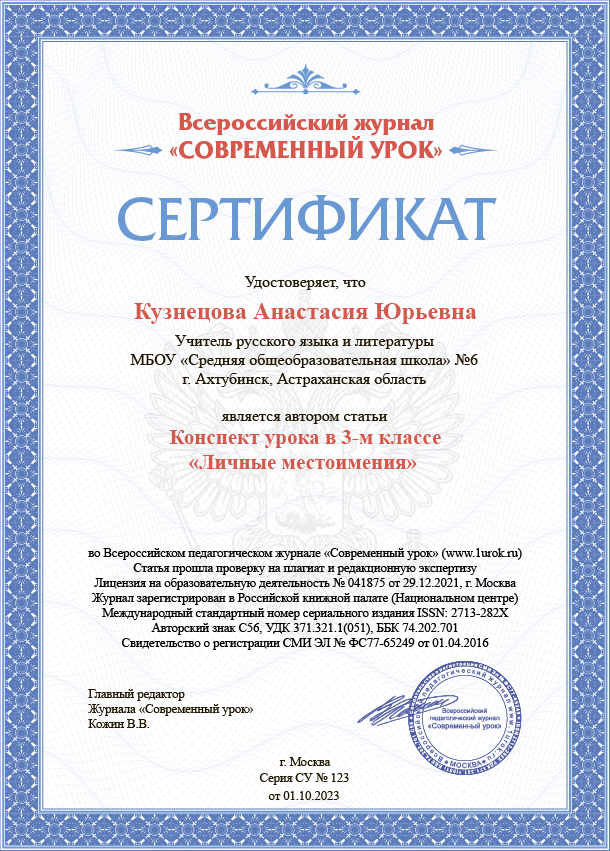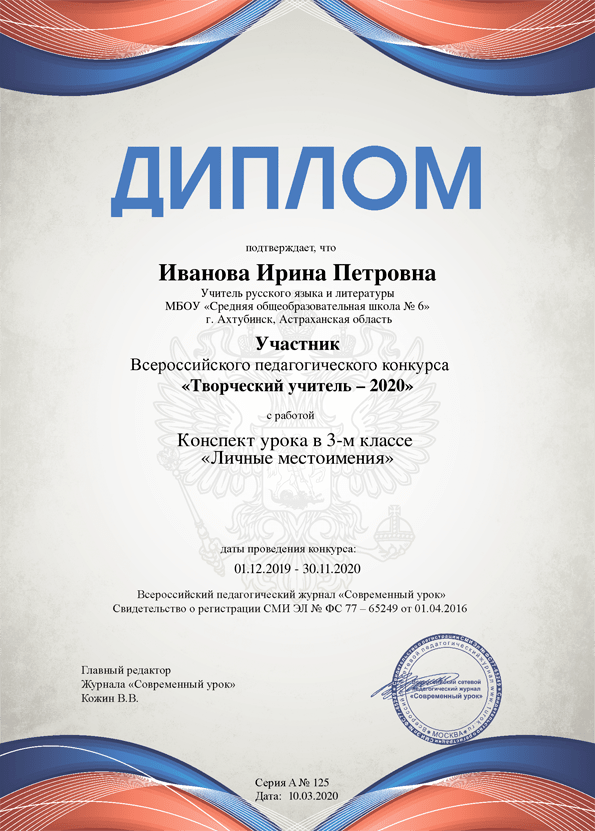Педагогические секреты: «Мотивация учащихся на достижение высоких результатов в изучении английского» (из опыта работы)
Автор: Мельничук Ирина Сергеевна
Организация: ГБОУ «Спец. школа с угл. изучением ин. языков № 115 г.о..Донецк»
Населенный пункт: ДНР г. Донецк
как мы учили вчера, мы украдем у детей завтра.
Джон Дьюи, американский философ, педагог.
Процесс передачи и получения знаний претерпел за свою историю немалые изменения. На сегодняшний день получение знаний – это взаимодействие ученика и учителя, т.е. интерактивные методы обучения в режиме диалога или беседы. Основные задачи интерактивных методов обучения: побуждение и повышение интереса учащихся к обучению; повышение эффективности усвоения учебного материала; установление взаимодействия между учащимися во время образовательного процесса; предоставление учащимся возможности самостоятельного поиска учебной информации; формирование у учащихся умения высказывать и отстаивать собственное мнение, аргументировать его.
Учебная программа строится, с учётом возрастных особенностей обучающихся. Для младших школьников больше подходит такой тип урока, как игра, путешествие, видео, сравнительные диаграммы, кластеры, пазлы. Взрослый ученик предпочитает классический урок (составить рассказ, сделать упражнение, прочитать текст, выполнить аудирование, метод проектов, деловые игры, круглые столы, мозговой штурм).
Лично я в своей работе использую разнообразные методы (набор приёмов и средств, которые помогают учителю и ученику вместе достичь целей в обучении) и методики активного обучения — в отличие от пассивной модели, ученик не просто слушает преподавателя или читает учебник, а сам ведёт познавательную работу. Кроме того, эти методы помогают развивать софт-скиллы, объединяют знания и навыки из разных дисциплин.
Коммуникативная методика — это подход к обучению языку, который делает упор на развитие коммуникативной компетенции. Она заключается в использовании изучаемых на уроках лексических единиц и грамматических конструкций в речи. Все занятия, разрабатываемые согласно этой методике, проводятся на иностранном языке, либо с минимальным включением родной речи. Учитель только направляет учеников, задает им вопросы и создает коммуникативную ситуацию, а 70% времени от всего занятия говорят ученики. (https://disk.yandex.ru/d/JbJ3LtdlS9Kmzg)
Проектная методика — это образовательная методика, в которой центр — учащийся, а цель — сделать его самостоятельным, креативным и инициативным. Её смысл состоит в использовании изученного материала на практике. К примеру, младшие школьники с удовольствием представляют свои проекты на темы «Мой дом», «Мое домашнее животное», «Мои любимые игрушки», а старшеклассники уже занимаются серьезными разработками, например, по тематике защиты окружающей среды. (https://disk.yandex.ru/d/zwBGU66prEuB6w)
Тренинговая методика
Тренинг – форма интерактивного обучения, целью которого является развитие компетентности межличностного и профессионального поведения в общении.
Тренинговый подход базируется на самостоятельном изучении, с той поправкой, что учащимся дается уже проработанный структурированный материал и наглядно объясняется учителем. Ученик получает порцию теории, запоминает правила и использует их на практике. Данная методика часто применяется в онлайн-обучении. Его главными преимуществами являются наличие продуманной программы, подача информации, необходимой для повышения уровня владения английским, в максимально доступной форме и возможность самостоятельно планировать учебный график.
(https://disk.yandex.ru/i/rc_k-HQvaIB61g https://disk.yandex.ru/i/-UwKheVgqbF1hA https://disk.yandex.ru/i/U570a-qW72yGqw)
Методы, используемые на уроках английского языка:
Игровой метод
Игровые методы обучения— это методы, которые в игровой форме воссоздают ситуации, направленные на усвоение норм и правил поведения в обществе, способствуют формированию социального опыта, совершенствуют навыки самоуправления поведением. В моей практике это:
•загадывание и отгадывание загадок; (https://disk.yandex.ru/i/Xt5ABZOWm7F8hg)
•введение элементов соревнования;(https://disk.yandex.ru/d/WUCPgUvfANc9LA)
• внезапное появление каких-то объектов;
(https://disk.yandex.ru/d/pbD1jgJ60dab1w)
• выполнение различных игровых действий.(https://disk.yandex.ru/i/iClVqkFqHUmSfQ)
Например, элементы соревнований можно вводить при выполнении практических заданий типа gaps filling (заполни пропуски) https://disk.yandex.ru/i/05DrGNwoXCeh6Q, chainword (найти в цепочке слова, выпиши, переведи) https://disk.yandex.ru/i/CRBYXT_-qz0Lrg match the pair (подобрать пару), scrambled sentences (составить предложение из слов) https://disk.yandex.ru/i/-5VVEApt82Sr1A Целесообразно использование на уроке magic box. (https://disk.yandex.ru/i/pfwIFUn4ZGPm5g) Использование passphrase/ password (пароля) – ключевая фраза или слово урока.( https://disk.yandex.ru/i/vRIXifDeKVoIiQ) Tic-tac word, Code words (записывание слова по буквам, которые пронумерованы), https://disk.yandex.ru/i/gOKVkOOU5HospQ Snowball – для развития памяти, Perform a command (Ореn thе dооr, shut thе window, tаkе thе bооk и т. д), Numbers (colours) and prepositions – развитие навыков аудирования. (https://disk.yandex.ru/d/VwG0LfwXgq30mA)
2. Словесный метод
Самый простой словесный метод используется на всех этапах урока и позволяет в кратчайший срок передать детям информацию, поставить перед ними учебную задачу, указать пути ее решения. Словесный метод сочетается с наглядными и игровыми методами, делая последние более результативными. Словесные методы подразделяются на следующие виды: рассказ, объяснение, беседа, дискуссия, лекция, работа с книгой.
Наиболее уместными считаю использование его при объяснении грамматики. Этот приём сочетается с наглядным. Так, например, в теме «Типы вопросов» использую словесный, наглядный и игровой приём. https://disk.yandex.ru/d/JbJ3LtdlS9Kmzg
3.Наглядный метод
Наглядные методы обучения — это методы, которые вносят разнообразие в методику преподавания, способствуют повышению продуктивности учебного занятия. Наглядные методы: наблюдение, иллюстрация, демонстрация.
1.Просмотр видеофильмов https://disk.yandex.ru/i/Wy25b5HWZX3W2g
2.Демонстрация иллюстраций https://disk.yandex.ru/i/lxzr8kc5V1gn6A https://disk.yandex.ru/i/26yf4eyqIPVewg
3.Представление презентаций https://disk.yandex.ru/i/pGFVcKPGoulY2w
4.Изготовление презентаций и проектов, подбор видеофильмов
Наглядность может быть языковая и зрительная. Поговорим о последней, т.к. 80% информации усваивается через орган зрения. Наглядность можно использовать на любом этапе урока. Иллюстрации, игрушки или видеофильмы можно подобрать к любой теме.
Приём обучения (обучающий приём) — это элемент метода, кратковременное взаимодействие между преподавателем и учениками, направленное на передачу и усвоение конкретного знания, умения, навыка.
Некоторые методические приемы, которые наиболее успешно применяются на уроках:
Прием «Фантастическая добавка»
Преподаватель дополняет реальную ситуацию фантастикой. Можно переносить учебную ситуацию на фантастическую планету, перенести реального или литературного героя во времени; рассмотреть изучаемую ситуацию с необычной точки зрения, например, глазами инопланетянина.
Прием «Корзина идей» (понятий, имен...)
Это прием организации индивидуальной и групповой работы учащихся на начальной стадии урока, когда идет актуализация имеющегося у них знаний. Он позволяет выяснить, что знают ученики по обсуждаемой теме урока. На доске можно нарисовать значок корзины, в которой условно будет собрано все, что все ученики вместе знают об изучаемой теме. Обмен информацией проводится по следующей процедуре:
1. Задается прямой вопрос о том, что известно ученикам.
2. Сначала каждый ученик вспоминает и записывает в тетради все, что знает по той или иной проблеме (строго индивидуальная работа, продолжительность 1–2 минуты).
3. Затем происходит обмен информацией в парах или группах. Ученики делятся друг с другом известным знанием (групповая работа). Время на обсуждение не более 3 минут.
Прием «Пометки на полях» или «ИНСЕРТ»
«Инсерт» - метод активного чтения, который помогает вдумчиво и внимательно читать текст. Этот прием является средством, позволяющим ученику отслеживать свое понимание прочитанного текста. Учеников надо познакомить с маркировочными знаками и предложить им по мере чтения ставить их карандашом на полях текста
Пометки должны быть следующие:
Знаком «галочка» (v) отмечается в тексте известная информация (степень достоверности ее не имеет значения).
Знаком «плюс» (+) отмечается новое знание. Ученик ставит этот знак в том случае, если он впервые встречается с прочитанным текстом. Знаком «минус» (–) отмечается то, что идет вразрез с имеющимися у ученика представлениями.
Знаком «вопрос» (?) Отмечается то, что осталось непонятным ученику.
Данный прием требует от ученика активного и внимательного чтения. Использование маркировочных знаков позволяет соотносить новую информацию с имеющимися представлениями.
Прием «Лови ошибку»
Объясняя материал, преподаватель намеренно допускает ошибки. Учащиеся заранее предупреждаются об этом. Учащийся получает текст со специально допущенными ошибками – выступают в роли учителя.
Прием «Читай, как автор»
Учащиеся смотрят фрагмент видео на иностранном языке. Учитель распечатывает текст с видео на листах. Следующий этап - ребятам демонстрируется видео без звука. Ученики сами читают текст под демонстрацию видео, повторяя интонацию автора и стараясь читать так, чтобы текст совпал с видео. https://disk.yandex.ru/i/tqC9hEEoOKQvng
Все перечисленные методы и приемы организации работы на уроках отвечают требованиям новых стандартов, помогают вовлечь наибольшее количество учащихся в образовательный процесс, повысить интерес к изучению иностранного языка. Ученики в процессе обучения овладевают навыками отбора информации, постановки цели и решения задач, которые пригодятся им не только в учебном процессе, но и в жизни. Взаимодействие и сотрудничество способствуют формированию культуры поведения.
Нет предпочтения какому-либо методу или приему. Все хороши для воспитания активной творческой личности.
Предвещая вопросы обучающихся - Зачем нужно изучать иностранный язык? Пригодится ли он? - Хочу сразу дать ответ: иностранный язык может помочь нам найти общий язык с иностранцами в путешествиях, получить новую должность, найти друзей со всего мира, иметь возможность читать литературу на языке оригинала или даже устроить личную жизнь.
А закончить я бы хотела словами одного из самых известных активистов в борьбе за права человека Нельсона Манделы: «If you talk to a man in a language he understands, that goes to his head. If you talk to him in his own language, that goes to his heart. - Если вы говорите с человеком на языке, который он понимает, вы обращаетесь к его уму. Если вы говорите с ним на его родном языке, вы обращаетесь к его сердцу».
How to motivate students to achieve high results in English
If we teach children today the way we taught yesterday, we will steal from children tomorrow. (John Dewey, American philosopher, educator).
The process of transferring and acquiring knowledge has undergone many changes in its history. Today, knowledge acquisition is the interaction between a student and a teacher, i.e. interactive teaching methods in the mode of dialog or conversation. The main objectives of interactive teaching methods are: to stimulate and increase students' interest in learning; to increase the effectiveness of learning material; to establish interaction between students during the educational process; to provide students with the opportunity to independently search for educational information; to form students' ability to express and defend their own opinion, to argue it.
The curriculum is built taking into account the age peculiarities of students. For younger pupils such type of lesson as a game, journey, video, comparative diagrams, clusters, puzzles is more suitable. An adult learner prefers a classic lesson (compose a story, do an exercise, read a text, perform listening, project method, business games, round tables, brainstorming).
Personally, in my work I use a variety of methods (a set of techniques and tools that help the teacher and the student to achieve learning goals together) and active learning techniques - unlike the passive model, the student does not just listen to the teacher or read the textbook, but does the cognitive work himself. In addition, these methods help to develop soft-skills, combine knowledge and skills from different disciplines.
Communicative methodology is an approach to language teaching that emphasizes the development of communicative competence. It consists in using the lexical units and grammatical constructions studied in the lessons in speech. All lessons developed according to this methodology are conducted in a foreign language, or with minimal inclusion of native speech. The teacher only guides the students, asks them questions and creates a communicative situation, and 70% of the time the students speak. (https://disk.yandex.ru/d/JbJ3LtdlS9Kmzg)
Project method is an educational method in which the student is the center and the goal is to make him/her independent, creative and initiative. Its meaning is to use the learned material in practice. For example, younger students are happy to present their projects on the topics of “My Home”, “My Pet”, “My Favorite Toys”, while high school students are already engaged in serious developments, for example, on the topic of environmental protection. (https://disk.yandex.ru/d/zwBGU66prEuB6w)
Training methodology. Training is a form of interactive learning, the purpose of which is to develop the competence of interpersonal and professional behavior in communication.
The training approach is based on self-study, with the amendment that students are given already worked out structured material and visually explained by the teacher. The student receives a portion of theory, memorizes the rules and uses them in practice. This methodology is often used in online learning. Its main advantages are the availability of a well-thought-out program, the presentation of the information necessary to improve the level of English in the most accessible form, and the ability to plan your own learning schedule.
(https://disk.yandex.ru/i/rc_k-HQvaIB61g
https://disk.yandex.ru/i/-UwKheVgqbF1hA
https://disk.yandex.ru/i/U570a-qW72yGqw).
Methods in English lessons:
Game method. Game methods of teaching are methods that in a game form recreate situations aimed at learning the norms and rules of behavior in society, contribute to the formation of social experience, improve the skills of self-management of behavior. In my practice these are:
- guessing and guessing riddles;
- (https://disk.yandex.ru/i/Xt5ABZOWm7F8hg)
-
introducing elements of competition; (https://disk.yandex.ru/d/WUCPgUvfANc9LA)
- sudden appearance of some objects;
-
(https://disk.yandex.ru/d/pbD1jgJ60dab1w)
- performing various play activities. (https://disk.yandex.ru/i/iClVqkFqHUmSfQ)
For example, elements of competition can be introduced when doing practical tasks like gaps filling https://disk.yandex.ru/i/05DrGNwoXCeh6Q, chainword (find words in a chain, write them out, translate them) https://disk.yandex.ru/i/CRBYXT_-qz0Lrg match the pair, scrambled sentences (make a sentence out of words) https://disk.yandex.ru/i/-5VVEApt82Sr1A It is reasonable to use magic box. (https://disk.yandex.ru/i/pfwIFUn4ZGPm5g) Using passphrase/ password - key phrase or word of the lesson. (https://disk.yandex.ru/i/vRIXifDeKVoIiQ) Tic-tac words, Code words (writing down the word by letters which are numbered), https://disk.yandex.ru/i/gOKVkOOU5HospQ Snowball - for memory development, Perform a command (Open the door, shut the window, close the window, so the window, etc.), Numbers (colors) and prepositions - development of listening skills. (https://disk.yandex.ru/d/VwG0LfwXgq30mA)
Verbal method.
The simplest verbal method is used at all stages of the lesson and allows to convey information to children in the shortest possible time, to set them a learning task, to indicate ways of its solution. The verbal method is combined with visual and game methods, making the latter more effective. Verbal methods are divided into the following types: story, explanation, conversation, discussion, lecture, work with a book.
I find it most appropriate to use it when explaining grammar. This technique is combined with a visual one. For example, in the topic “Types of questions” I use the verbal, visual and game method. https://disk.yandex.ru/d/JbJ3LtdlS9Kmzg.
3.Visual method. Visual methods of teaching are methods that bring variety in teaching methods, contribute to the productivity of the training session. Visual methods: observation, illustration, demonstration.
1.Viewing videos https://disk.yandex.ru/i/Wy25b5HWZX3W2g
2.Demonstration of illustrations https://disk.yandex.ru/i/lxzr8kc5V1gn6A https://disk.yandex.ru/i/26yf4eyqIPVewg
3.Presentation of presentations https://disk.yandex.ru/i/pGFVcKPGoulY2w
4.Making presentations and projects, selecting videos.
Visibility can be linguistic and visual. Let's talk about the latter, because 80% of information is absorbed through the organ of vision. Visuals can be used at any stage of the lesson. Illustrations, toys or videos can be matched to any topic.
Teaching technique (teaching technique) is an element of a method, a short-term interaction between a teacher and students, aimed at transferring and assimilating a specific knowledge, skill or ability.
Some methodological techniques that are most successfully used at lessons:
Fiction Supplementation” technique.
The teacher supplements the real situation with fiction. It is possible to transfer the learning situation to a fantastic planet, to move a real or literary hero in time; to consider the learning situation from an unusual point of view, for example, through the eyes of an alien.
The “Basket of Ideas” (concepts, names...) technique
This is a technique of organizing individual and group work of pupils at the initial stage of the lesson, when there is an actualization of their existing knowledge. It allows you to find out what pupils know about the topic under discussion. On the blackboard it is possible to draw a symbol of a basket in which everything that all pupils together know about the topic under study will be collected. The exchange of information follows the following procedure:
1. A direct question is asked about what the students know.
2. First, each student recalls and writes down in a notebook everything he or she knows about a particular problem (strictly individual work, duration 1-2 minutes).
3. Then information is shared in pairs or groups. Pupils share what they know with each other (group work). The time for discussion is no more than 3 minutes.
The technique of “notes in the margins” or “INSERT”.
“Insert” is a method of active reading that helps to read the text thoughtfully and attentively. This technique is a means for students to monitor their understanding of the text they are reading. Pupils should be introduced to marking marks and asked to put them in pencil in the margins of the text as they read.
Markings should be as follows:
A “check mark” (v) marks known information in the text (its degree of reliability is irrelevant).
A plus sign (+) marks new knowledge. The student puts this mark if it is the first time he/she has encountered the text he/she has read. A minus sign (-) indicates something that goes against the student's existing ideas.
A “question” (?) marks what the student does not understand.
This technique requires the student to read actively and attentively. The use of markers allows the student to relate new information to existing ideas.
Catch a mistake” technique
While explaining the material, the teacher intentionally makes mistakes. Students are warned about it in advance. A student receives a text with deliberately made mistakes - they act in the role of the teacher.
“Read like an author” technique.
Pupils watch a fragment of a video in a foreign language. The teacher prints out the text from the video on a sheet of paper. The next stage - a video without sound is shown to the pupils. Pupils themselves read the text to the video, repeating the author's intonation and trying to read so that the text coincides with the video. https://disk.yandex.ru/i/tqC9hEEoOKQvng
All the above methods and techniques of organizing work at lessons meet the requirements of the new standards, help to involve the largest number of students in the educational process, increase interest in learning a foreign language. Pupils in the process of learning master the skills of information selection, goal setting and problem solving, which will be useful to them not only in the learning process, but also in life. Interaction and cooperation contribute to the formation of a culture of behavior.
There is no preference for any method or technique. All are good for nurturing an active creative personality.
Anticipating the questions of the learners - Why do I need to learn a foreign language? Will it be useful? - I would like to give an answer at once: a foreign language can help us to find a common language with foreigners when traveling, to get a new position, to find friends from all over the world, to be able to read literature in the original language or even to organize our personal life.
And I would like to end with the words of one of the most famous human rights activists, Nelson Mandela: “If you talk to a man in a language he understands, that goes to his head. If you talk to him in his own language, that goes to his heart”.








